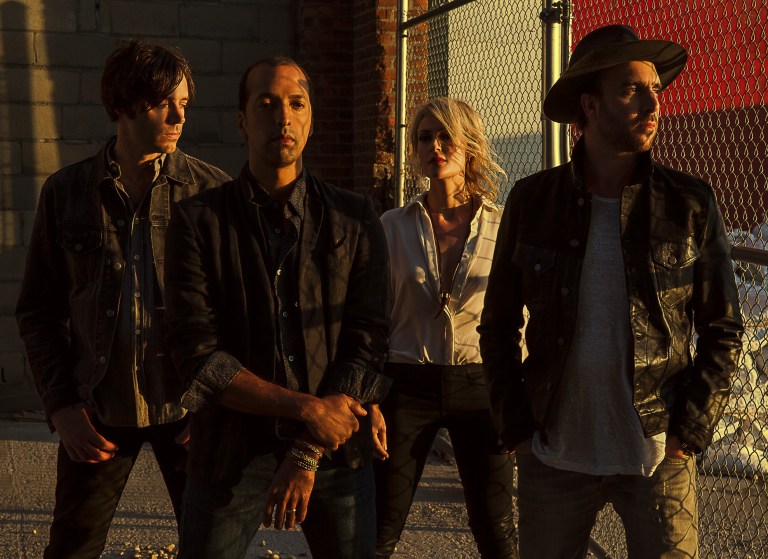Metric’s ‘last vestige of caring’ prompts ‘Pagans’

Metric, Courtesy.
Pros, cons and hindsight, Toronto synth-pop quartet Metric has never shied away from direction-shaping changes. In 2007, the band ditched a traditional label to start their own distribution company. The move paid off two years later when their fourth album, Fantasies, and lead single “Help I’m Alive” charted in the U.S. and became indie hits. The success propelled the band to 2012’s Synthetica, which registered on two Billboard charts, won two Juno Awards in Canada and led to an arena tour in their home country. But financially, the album didn’t live up to their expectations.
Metric, Joywave
8 p.m., Feb. 23
The Masonic
Tickets: $41.
“We had ambitions to do other types of tours and we had ambitions to do other sorts of soundtracks and reach sales goals and chart goals, and it didn’t really happen,” said guitarist-producer Jimmy Shaw, who, along with vocalist Emily Haines, is the creative drive of the band. “I think that was the last vestige for me of caring. You can’t really expect yourself to really let go and make the art that actually wants to come out of you…and expect it to hit a certain number on a chart. It doesn’t work that way.”
With that attitude, the band, which includes drummer Joules Scott-Key and bassist Joshua Winstead, took a break in 2014. Shaw used the time to write new songs, like usual, on drum machines and modular synths in his home studio, and Haines on an acoustic guitar and piano while traveling in Nicaragua and Spain. Her “sad, moody, broody” songs were akin to her 2006 solo album, Knives Don’t Have Your Back, he said.
Typically, when the band sits down to complete the songs, both styles are brought closer together by adding electric guitar and drums to create more of a rock and roll sound. This time, they decided to let the two records rest on either side of the rock sound. Pagans in Vegas, their sixth record that was released last September, was made with that philosophy. It was meant to be the first half of a double album. As recently as October, the plan was to release the acoustic seventh record early this year. That idea has been scrapped.

Emily Haines of Metric performs at The Masonic in San Francisco on Feb. 23, 2013. Roman Gokhman/STAFF.
The Haines songs were recorded piecemeal while Metric was on the road with Imagine Dragons in 2015. The tour put the indie band in front of diverse audiences, but it also threw them out of sync in terms of recording, which took place in Steve Albini’s Chicago space, Nashville’s Blackbird Studios, The Village Studio in Los Angeles, and elsewhere.
“We didn’t really have a chance to listen to (the acoustic) record until last December when all the touring was over,” Shaw said. “When we sat down and listened to it, it was not entirely what we thought was the right thing to go forward with. I think the record actually has the skeleton to be a much bigger and more important thing than we thought it was going to be.”
In other words, by the time fans hear the Haines-penned songs — be it in six months, nine months, or later — they could sound very different.
“We wanted to go chase that instead of letting it be a one- or two-color record,” Shaw said. “The part of Emily that…sits at the grand piano and plays a beautiful, melancholy, sad song is a huge part of who we are and what we do, but it can’t be all of what we do for one whole phase.”
Shaw acknowledged that because it has no contrasting partner, Pagans may appear as a misfire.
“Pagans would have made more sense if it was the half of a double album,” he said. “For logistical reasons, it didn’t work out that way. This would get us kicked off a major label.”
The album is the farthest Metric has strayed from their indie rock roots. Inspired by the likes of Kraftwerk, Underworld, The Cure and New Order, it was recorded with no instruments made past 1970.
Opening track “Lie Lie Lie” darkly sways between synth-pop and electronic dance music in a commentary about how magazine covers rule over opinions. Third track “The Shade” is a glitchy ode to love — a lyrical departure for Haines, who usually covers snarkier topics. The next two tracks, “Celebrate” and “Cascades” feature no guitar whatsoever. The album closers, “The Face Part I” and “Part II,” provide Shaw an opportunity to go full-on instrumental and ambient.
“Really, what I was doing was just obeying where this writing started from and not just try to morph it into something that we’ve done before,” Shaw said. “That felt like a departure.”
Winstead and Scott-Key were supportive of the new direction, even if their contributions may have been minimized slightly, Shaw said. And Pagans songs have blended into the band’s live set naturally. Fans of the band who don’t understand the new album will see it in an appropriate context after seeing the songs performed live, he said.
- RELATED STORIES:
Metric rides success of ‘Fantasies’ to South by Southwest - Metric’s magical collaboration with Lou Reed
- Metric’s Jimmy Shaw calls his own shots
- PHOTOS: Metric and Zoé lead lineup of contrasting indietronica at the Masonic
- ALBUM REVIEW: Metric turns up the indie rock fuzz on ‘Art of Doubt’
- REVIEW: Emily Haines plays her own muse at GAMH
Eighteen years since Shaw and Haines met in New York, sharing a loft with members of the Yeah Yeah Yeahs and TV on the Radio at a time when no one had money, Metric shows no signs of slowing down.
Shaw isn’t afraid to look back to try and imagine where Metric could be right now had they signed with a major label. Shaw is sure it would be difficult to gain traction without a major label investment. Still, he doesn’t see the band becoming successful in that scenario because he and Haines have never worked well with others telling them what to do. That’s why they’re satisfied with their place in the world of music.
“I want it to be the alternative to mainstream, within the mainstream,” he said. “I want it to be on the radio, and I want it to sound exactly like me. I didn’t want to sound like anything else.”
Follow editor Roman Gokhman at Twitter.com/RomiTheWriter.
